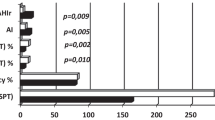Abstract
Urolithiasis is a common urologic problem among adults worldwide. It is interesting that urinary stones tend to recur on the same side and the pathophysiology of unilateral stone formation is not clearly understood. Researchers found that sleep posture could alter renal perfusion, and subsequent vascular injury may lead to urolithiasis formation. The aim of this study is to retrospectively evaluate the correlations between the specific sleep postures recorded in polysomnography (PSG) and the stone laterality in unilateral urinary stone formers with obstructive sleep apnea (OSA). We retrospectively reviewed patients receiving PSG for the diagnosis of OSA in our institutes between January 1st 2002 and September 30th 2016. Those had a history of unilateral urinary stones which surgical intervention was warranted were included. Supine, prone, right decubitus, and left decubitus sleep postures were determined as patients remained specific postures for more than 50% of their sleep time. The laterality of stones with sleep posture was analyzed with Chi-square test. A student t test was used to assess factors that influenced the ipsilateral stone formation. IBM SPSS Statistics 21 software was adopted to analyze the data, and p value less than 0.05 was considered statistically significant. 117 patients were enrolled in this study, among which 105 (89.7%) were male and 12 were female. The mean age at PSG examination was 53.5 ± 11.5 years. 66 patients were diagnosed as left-side urolithiasis, and 51 patients had urinary stones at right side. 58 (49.6%) patients slept predominantly in supine posture, while 53 (45.3%) patients, in decubitus posture, and no patient, in prone posture. A total of 51 patients’ stones appeared at the same side as their decubitus posture (p < 0.0001). Shorter sleep stage I ratio (24.3 ± 15.5% versus 52.4 ± 24.7%, p = 0.017), longer sleep stage II + III + IV ratio (66.2 ± 21.9% versus 30.9 ± 2.8, p = 0.049), and less sleep stage change (176.6 ± 69.6 times versus 282.5 ± 91.2 times, p = 0.041) were correlated with stone formation on the same side. Age, gender, body mass index, and other polysomnographic parameters failed to demonstrate associations between the sides of urinary calculi and sleep postures. We discovered that sleep posture is associated with unilateral urolithiasis formation. Favorable sleep quality and less sleep stage changes could consolidate the correlations. Further prospective study is warranted to evaluate the effect of sleep posture and quality on non-OSA patients as well as the preventive effect of sleep posture modification on repeated unilateral stone formers.
Similar content being viewed by others
References
Bartoletti R, Cai T, Mondaini N, Melone F, Travaglini F, Carini M, Rizzo M (2007) Epidemiology and risk factors in urolithiasis. Urol Int 79(Suppl. 1):3–7
Trinchieri A, Ostini F, Nespoli R, Rovera F, Montanari E, Zanetti G (1999) A prospective study of recurrence rate and risk factors for recurrence after a first renal stone. J urol 162(1):27–30
Ketata S, Ketata H, Sahnoun A, Slimen MH, Fakhfakh H, Bahloul A, Mhiri M (2008) Laterality of symptomatic recurrent calcium nephrolithiasis. Afr J Urol 14(3):143–146
Shekarriz B, Lu H-F, Stoller ML (2001) Correlation of unilateral urolithiasis with sleep posture. J urol 165(4):1085–1087
Schwartz BF, Dykes TE, Rubenstein JN, Stackhouse GB, Stoller ML (2007) Effect of body position on renal parenchyma perfusion as measured by nuclear scintigraphy. Urology 70(2):227–229
Stoller ML, Meng MV, Abrahams HM, Kane JP (2004) The primary stone event: a new hypothesis involving a vascular etiology. J urol 171(5):1920–1924
Tseng C-H, Lin F-C, Chao H-S, Tsai H-C, Shiao G-M, Chang S-C (2015) Impact of rapid ascent to high altitude on sleep. Sleep Breath 19(3):819–826
Force AAoSMT (1999) Sleep-related breathing disorders in adults: recommendations for syndrome definition and measurement techniques in clinical research. Sleep 22:667–689
Eeg A (1992) Scoring rules and examples: a preliminary report from the sleep disorders atlas task force of american sleep disorders association. Sleep 15:173–184
Rechtschaffen A (1968) A manual for standardized terminology, techniques and scoring system for sleep stages in human subjects. NIH Publication No. 204. Government Printing Office, Washington, DC, pp 5–6
Ziaee SAM, Hosseini SR, Kashi AH, Samzadeh M (2011) Impact of sleep position on stone clearance after shock wave lithotripsy in renal calculi. Urol Int 87(1):70–74
Türk C, Petřík A, Sarica K, Seitz C, Skolarikos A, Straub M, Knoll T (2016) EAU guidelines on interventional treatment for urolithiasis. Eur Urol 69(3):475–482
Schirmer H, Stenersen R, Jackson M (1970) The influence of renal ischemia on oxamide nephrolithiasis. Invest Urol 7(4):329–332
Laffan A, Caffo B, Swihart BJ, Punjabi NM (2010) Utility of sleep stage transitions in assessing sleep continuity. Sleep 33(12):1681–1686
van Maanen JP, de Vries N (2014) Long-term effectiveness and compliance of positional therapy with the sleep position trainer in the treatment of positional obstructive sleep apnea syndrome. Sleep 37(7):1209–1215
Bruyneel M, Libert W, Ameye L, Ninane V (2015) Comparison between home and hospital set-up for unattended home-based polysomnography: a prospective randomized study. Sleep med 16(11):1434–1438
Funding
none
Author information
Authors and Affiliations
Corresponding author
Ethics declarations
Conflict of interest
Tzu-Yu Chuang declares that he/she has no conflict of interest. Yi-Chun Chiu declares that he/she has no conflict of interest. Yu-Hua Fan declares that he/she has no conflict of interest. Shyh-Chyi Hung declares that he/she has no conflict of interest. Wei-Ming Cheng declares that he/she has no conflict of interest.
Ethical approval
All procedures performed in studies involving human participants were in accordance with the ethical standards of the institutional and/or national research committee and with the 1964 Helsinki declaration and its later amendments or comparable ethical standards. This article does not contain any studies with human participants performed by any of the authors.
Additional information
Publisher's Note
Springer Nature remains neutral with regard to jurisdictional claims in published maps and institutional affiliations.
Rights and permissions
About this article
Cite this article
Chuang, TY., Chiu, YC., Fan, YH. et al. Better sleep quality could reinforce the relationship between sleep posture and kidney stone laterality in obstructive sleep apnea patients. Urolithiasis 48, 245–249 (2020). https://doi.org/10.1007/s00240-019-01145-x
Received:
Accepted:
Published:
Issue Date:
DOI: https://doi.org/10.1007/s00240-019-01145-x




